By Daniel Bourmaud
Translation: Brad Pizzimenti
Passage au crible n°27

Pixabay
The tension observed on the Korean peninsula since the beginning of 2010 has seen a brutal resurgence with the sinking of a South Korean warship resulting in 46 deaths on the 26th of March 2010. In this case, Seoul accused Pyongyang of having deliberately torpedoed its warship, the Cheonan. The result has been economic and commercial sanctions brandished by the South Korean president, to which North Korea responded in breaking all relations with its southern neighbor, carrying out new military maneuvers, and reinforcing its nuclear arsenal since the end of June.
> Historical background
> Theoretical framework
> Analysis
> References
This tension is part of a long history spanning more than a half-century. The Korean War had officialized the split between the two territories situated on either side of the 38th parallel. After three years of fighting between 1950 and 1953 – the most deadly of the 20th century with the exception of the two world wars – the conflict ended with the signature not of a peace treaty but an armistice, singed in Pan-Munjon.
After being labeled essential for the status quo during the Cold War, inter-Korean relations have entered a new phase with their admission to the United Nations in 1991, and the conclusion of a non-aggression pact. This marked the beginning of an era of rapprochement, of the sunshine policy – symbolized notably by the implementation of liaison offices, an economic aid program for the north from the south, and meetings between separated families – whose crowning achievement is the opening of the special economic zone in Kaesong. Nevertheless, the decision of President Bush to register, in 2002, North Korea in the Axis of Evil served to reinforce its siege mentality. Its original acceptance of multiparty talks within the framework of the group of six – United States, China, the two Koreas, Japan, and Russia – and the return of the nuclear menace illustrated by the end of the NPT (Non-Proliferation Treaty), had thereafter changed to an isolationist strategy.
The constructivist theory appears particularly appropriate for capturing the political and social dynamics, because, according to Alexander Wendt, the identity of actors constitutes a powerfully explicative variable. A psychological approach to the political permits, as well, a better apprehension of the manners in which a conflict is interwoven and informs the representations that actors have of their own interests.
Two configurations permit restoring the complexity of these processes. Firstly, low self-esteem may be experienced as a humiliation, which must be shed by a counter action. But the protagonist may also, as Philippe Braud writes “make use of certain attacks on its dignity”. To assume the posture of the victim and “allow for actions of legitimate defense that are, in reality, belligerent”.
With a westernized reordering of roles, Pyongyang incarnates marvelously the villain. In effect, the western countries see in North Korea the quintessential duplicity. Its procrastinations and delay tactics are felt as brutally as its explicit claim to the right to the ultimate weapon, the nuclear bomb. This behavioral orientation has a blind spot however: in masking the vision that North Korea makes itself and thereby the way it designs its behavior towards others.
An identity threatened and wounded North Korea‘s pride of identity has roots in the ancient and glorious history of Kokouryo (277 BCE – 676 CE) that extended into China with Pyongyang as its capital. Today, once again, it claims the heritage of this state that unified Korea from the 10th to the 14th centuries. As a source of pride, this glorious state was threatened in the XIXth century by western states, Japanese colonization from 1905 to 1945 and as well by the imperial domination of the United States through the Korean War.
To qualify this country as the “last Stalinist state on the planet” comforts it in its siege mentality. Safeguards with respect to North Korea have never proven useful, but their absence turns out to be counterproductive. In calling it a delinquent state, the United States, which appeals to, in reality, moral categories, afflicts an even greater blow than its presence in South Korea. The need of Pyongyang to no longer be on this list, seen as slanderous, aims at escaping resulting sanctions but also to regain a lost pride.
An identity used. For the North Korean leadership, a posture of victimization is evidenced as a powerful instrument of mobilization and consolidation. In this spade, the recurrence of physical violence comes as a response to a symbolic violence that is felt by victims.
Such an analysis certainly departs from common approaches. It may also appear as a provocation, such that the North Korean regime appears to take on the properties of a dangerous power with a character as dictatorial as fantastic, as well as containing systematized coercion. Finally, the identity dimension remains in fine determinate. We better understand why Andrei Lankov – one of the most informed specialists on the Korean question – begins to advocate not just sanctions, that is to say, force, but the slow task of changing North Korean opinion.
Braud Philippe, L’Émotion en politique, Paris, Presses de Sciences Po, 1996.
Braud Philippe, « La Violence symbolique dans les relations internationales », Association Française de Science Politique, Congrès de Toulouse, Table ronde 6, 2007.
Lankov Andrei, “Changing North Korea, An information Campaign can Beat the Regime”, Foreign Affairs, 88 (6), Nov.-Dec. 2009, pp. 95-105.
Lindemann Thomas, Sauver la face, sauver la paix. Sociologie constructiviste des crises internationales, Paris, L’Harmattan, 2010. Coll. Chaos International.
Wendt Alexander, Social Theory of International Politics, Cambridge, Cambridge University Press, 1999.



